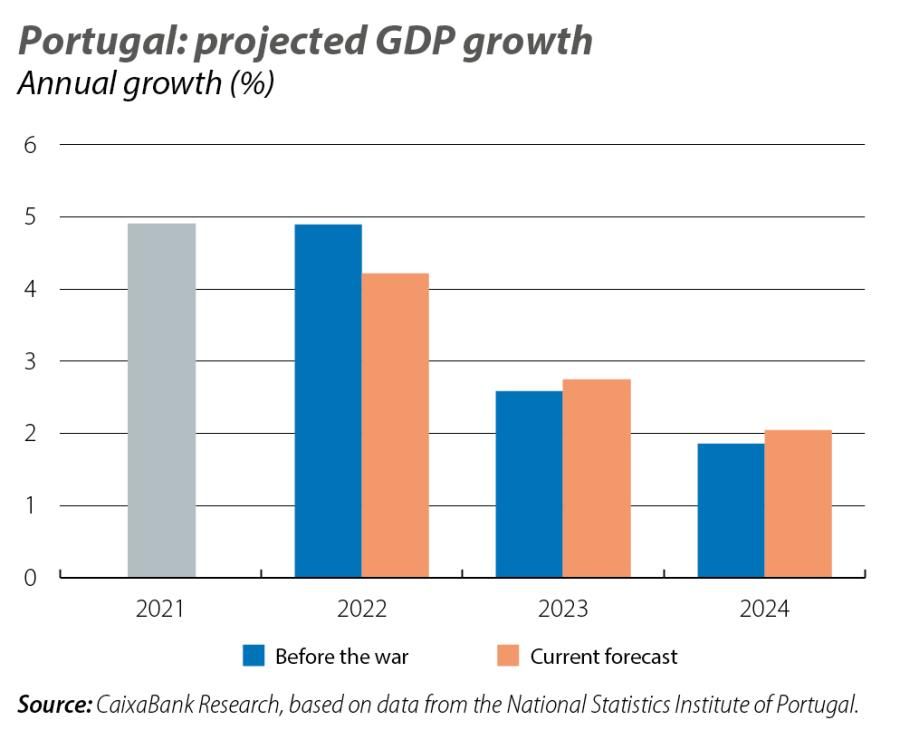Portugal: what impact will the conflict in Ukraine have on growth?
Up until 24 February, the day when Russian troops invaded Ukraine, the outlook for the growth of the Portuguese economy in 2022 was looking bright. On the one hand, the carry-over effect from 2021 had already itself generated growth of 3.7 pps. On the other hand, investment, consumption and exports were expected to perform well: investment would benefit from the receipt of European funds and the implementation of the RRP; consumption would benefit from the pent-up savings and spending plans deferred during the lockdowns, and tourism, from the recovery of mobility permitted by the greater control of the pandemic. Therefore, before 24 February we were going to revise the forecast for 2022 GDP growth (4.9%) up to 5.5%-6%.

However, the war has turned the situation on its head, and instead of revising the forecasts up we are forced to revise them down: we now estimate that growth in 2022 could be reduced to 4.2%, 7 decimal points below our previous forecast. This forecast is subject to a high degree of uncertainty.
Probably the most significant impact will come from the rise in energy instead of gas prices. But there are other impacts, particularly those related to the confidence of economic agents, which could hamper the recovery in consumption and tourism and trigger a deterioration of Portugal’s risk premium.
As a starting point, to estimate the new growth rate expected in 2022, we must take into account the fact that growth in Q4 2021 was stronger than that incorporated into our forecasts. This has a positive impact equivalent to 1 pp on growth in 2022, partly offsetting the negative impacts derived from the conflict.
That said, in a scenario in which the average price of oil is around 105 dollars a barrel (around 16 dollars more than in our initial scenario) and the gas price is rising to around 125 dollars per megawatt on average (50 euros more), and assuming, as seems reasonable, that the demand for these types of goods is relatively rigid (since consumers are unable to easily replace them in the face of a price increase), we estimate that the higher energy prices could subtract 1.1 pps from GDP growth.
The potential impact on the recovery of tourism could also have a cost in terms of growth. Although it is more difficult to estimate, while it is true that Portugal could benefit from the shift of demand from territories that are closer to the conflict and the fact that it is perceived as a safe destination, tourism movements are likely to be affected by deteriorating confidence and the loss of household purchasing power due to rising inflation. We estimate that this could subtract 3 decimal points from growth.
The increasing financing costs of the Portuguese economy, associated with the ECB’s debt-purchasing programmes coming to an end1 or the flight to quality that is common in periods of heightened uncertainty, will also have an unfavourable impact on growth, which we estimate at 2 decimal points. Finally, other impacts associated with the deferral of consumption and investment decisions, driven by factors such as the heightened uncertainty and the need to spend more on energy, could deduct 1 decimal point from growth.
In short, this first attempt at building a new outlook scenario for Portugal’s economic growth (taking into account the conflict between Russia and Ukraine and assuming that the tensions ease during the second half of the year) suggests that we will have to wait until early 2023 to see a recovery of pre-COVID levels – a milestone we previously expected to be achieved in mid-2022.
- 1. The ECB will bring its debt-purchase programme to an end this year, but it will continue to reinvest the debt maturities, thus ensuring a significant presence in the sovereign-debt market.